Joining the Campaign for Real Ale
7th June 2025

The photo is of the Olde Trip to Jerusalem pub in Nottingham. It’s one of the oldest pubs in the country, possibly the oldest.
Over Christmas 1973/74 my friend John and I went for a drink at the Childwall Fiveways pub in Liverpool. We had a couple of pints in the bar, but they were not very good, so we gave up and went home.
On the way home John said that someone he knew, had told him that the beer at the Prince Alfred, Wavertree and at the Wheatsheaf, Knotty Ash (yes, the place actually does exist) had excellent beer.
The following night we decided to go to the Wheatsheaf to check out the beer. It was absolutely fantastic; we necked four pints in the time we had before being kicked out. It was totally different to the beer we had the previous night. On the way back home we discussed this, John said that maybe it was the way the beer was dispensed. A method we came to know as dispense by handpump. We just didn’t know. All we did know is that one pub had crap beer and one pub had fantastic beer!
At the time I was studying Engineering at Sheffield University.
A couple of days after getting back to Sheffield, I found myself in a pub called the Red House, a Wards Pub. The beer was excellent, and it came from a handpump. The pub became one of my favourites.
Back at the student’s union, the beer was crap. In a pub near the Engineering Faculty that I frequented (The Beehive) the beer was also crap. With fellow students, I liked to visit pubs that sold Grotneys (ops Watneys) Red and Courage Tavern. Beers I came to despise, they were horrible. Looking back, I can’t believe I ever drank them.
Round the corner from the Beehive was the Red Deer, a Tetley’s pub. The beer was excellent and guess what, it came from a handpump.
The penny was starting to drop.
A short while later I was reading a piece in The Guardian, about how the quality of beer was getting worse, and how good, traditional beer was disappearing fast. To be replaced by what came to be called Keg beer. It mentioned a group called the Campaign for Real Ale, which was fighting this. So, I joined, and I’ve been a member ever since. I was one of the Guardian in-take.
On joining, I discovered the Good Beer Guide. And guess what, the Wheatsheaf, the Prince Alfred, the Red House and the Red Deer were all in it. I quickly found all the pubs in Sheffield that sold good real ale. Back in Liverpool the following Easter I started to find the pubs that sold good real ale there. The Wheatsheaf and the Prince Alfred became firm favourites, mainly because I could walk to them from my parents’ house.
Real ale is brewed from traditional ingredients, matured by secondary fermentation in the container from which it is dispensed, and served without the use of extraneous carbon dioxide. The pipes delivering it to the handpump must be spotless, and the cleaning must be done frequently. Real ale delivered through dirty pipes is awful.
Keg beer is beer that is filtered and pasteurised (unlike real ale, it is dead), stored in a sealed container (called a keg) and served by pumping carbon dioxide into the container to force the beer out. It was even worse in the Fiveways. In many of their pubs, Higson’s used tankers (rather like tankers delivering petrol) to deliver the beer to the pub. They had huge tanks in the cellar into which the beer was pumped. It was served the same way as keg beer.
The big breweries wanted us to drink keg beers because quality control was easier.
CAMRA is one of the most, if not the most successful campaign in the country. Without them we would all be drinking bland beers produced by a handful of breweries. A far cry from what we have now.
First Published: 7th June 2025
Author: Paul Chappell